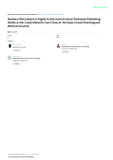| dc.contributor.author | Wafula, P | |
| dc.contributor.author | Were, T | |
| dc.contributor.author | Barasa, M | |
| dc.date.accessioned | 2024-01-12T15:05:47Z | |
| dc.date.available | 2024-01-12T15:05:47Z | |
| dc.date.issued | 2021-05-05 | |
| dc.identifier.uri | https://www.researchgate.net/profile/Wafula-Philemon/publication/342625820_Anaemia_Phenotypes_in_Highly_Active_Antiretroviral_Treatment_Defaulting_Adults_at_the_Comprehensive_Care_Clinic_at_the_Siaya_County_Teaching_and_Referral_Hospital/links/624751645e2f8c7a03507ece/Anaemia-Phenotypes-in-Highly-Active-Antiretroviral-Treatment-Defaulting-Adults-at-the-Comprehensive-Care-Clinic-at-the-Siaya-County-Teaching-and-Referral-Hospital.pdf | |
| dc.identifier.uri | http://ir-library.mmust.ac.ke:8080/xmlui/handle/123456789/2546 | |
| dc.description.abstract | Background: Anaemia is a major cause of morbidity and mortality among people living with human immunodeficiency virus (HIV)
infection. While adherence to antiretroviral treatment (ART) reduces the incidence of anaemia, non-adherence (defaulting) to ART
is associated with a number of haematologic derangements including anaemia. However, the mechanisms and predictors of anaemia
have not been examined among ART defaulters in western Kenya. This study, therefore, aimed at evaluating the anaemia prevalence
and classification of the anaemia based on haemoglobin (Hb) concentrations and erythrocyte morphology as well as suppression of
erythropoiesis in ART-defaulting adults at a comprehensive care clinic in western Kenya.
Methods: This cross-sectional study was conducted among HIV-infected adults (≥18 years) at Siaya County Teaching and Referral
Hospital Comprehensive Care Clinic from January to July, 2018. All blood samples were collected between 8.00-10.00 hours and
automated haematology analyzer used for assessing full-haemograms. CD4 counts were enumerated using the Swelab Alfa machine.
Reticulocyte counts were determined using new methylene blue staining.
Result: The overall rates of anaemia was higher in the ART-defaulters (87.9%) compared to the ART-adherent (53.7%) and -naive
(55.5%) patients (P < 0.0001). The rates of severe and moderate anaemia were higher in ART-defaulters (40.4% and 28.3%) relative to
ART-adherent (8.5% and 15.9%) and naive (8.7% and 20.3%) individuals, respectively (P < 0.0001). Morphologic phenotypes of the
anaemia were predominantly microcytic and hypochromic anaemia dominated in the ART-defaulters (54.5% and 64.7%) compared
to the ART-adherents (8.5% and 32.9%) and naive (8.7% and 17.4%) patients (P < 0.0001), respectively. Binary logistic regressions
indicated that anaemia was associated with under-nutrition (OR, 5.634; 95% CI, 1.844-17.213; P = 0.002); microcytic (OR, 37.771;
95% CI, 8.604-160.581; P < 0.0001) and hypochromic (OR, 42.982; 95% CI, 8.622-214.267; P < 0.0001) cells; and severe immune
suppression (OR, 168.476; 95% CI, 9.872-2875.17; P < 0.0001) in the ART-defaulters.
Conclusion: These results suggest that targeted interventions involving improving adherence and nutritional management can lower
the burden of anaemia among ART-defaulters | en_US |
| dc.language.iso | en | en_US |
| dc.publisher | Journal of AIDS and HIV Infections | en_US |
| dc.subject | Anaemia, Phenotypes, Highly, Active, Antiretroviral, Treatmen, Defaulting, Adults,Comprehensive, Care, Clinic, County, Teaching, Referral Hospital | en_US |
| dc.title | Anaemia Phenotypes in Highly Active Antiretroviral Treatment Defaulting Adults at the Comprehensive Care Clinic at the Siaya County Teaching and Referral Hospital | en_US |
| dc.type | Article | en_US |

